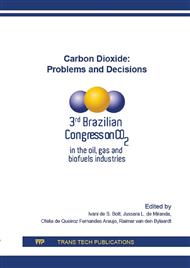[1]
IPCC- Intergovernmental Panel on Climate Change (2014) Greenhouse gas emissionsacceleratedespite reduction efforts. Information on: http: /ipcc. ch/pdf/ar5/pr_wg3/20140413_pr_pc_wg3_en. pdf.
Google Scholar
[2]
F. M. Vichi, M. T. C. Mansor. Energia, meio ambiente e economia: o Brasil no contexto mundial. Quím. Nova. 32(2009) 757-767.
DOI: 10.1590/s0100-40422009000300019
Google Scholar
[3]
D. Jeremy. Economic evaluation of leading technology options for sequestration of carbon dioxide. M. S thesis, MIT, Cambridge, MA, (2000).
Google Scholar
[4]
Audus, H. Leading options for the capture of CO2 at power stations. In: Presented at the 5th International Conference on Greenhouse Gas Control Technologies, Cairns, Australia, (2000) 13–16.
Google Scholar
[5]
C. Song, Y. Kitamura, S. Li, K. Ogasawara. Design of a cryogenic CO2 capture system based on Stirling coolers. International Journal of Greenhouse Gas Control. 7 (2012) 107–114.
DOI: 10.1016/j.ijggc.2012.01.004
Google Scholar
[6]
L. Lin, H. Bay Continuous generation of mesoporous silica particles via the use of sodium metasilicate precursor and their potential for CO2 capture. Microporous and Mesoporous Materials. 136 (2010) 25–32.
DOI: 10.1016/j.micromeso.2010.07.012
Google Scholar
[7]
C. C. Costa, D. M. A. Melo, M. A. F. Melo, M. E. Mendoza, J. C. Nascimento, J. M. Andrade, et al. Effects of different structure-directing agents (SDA) in MCM-41 on the adsorption of CO2. Journal of Porous Materials. 21 (2014) 1069-1077.
DOI: 10.1007/s10934-014-9857-9
Google Scholar
[8]
K. S. N. Kamarudin, N. Aliais. Adsorption performance of MCM-41 impregnated with amine for CO2 removal, Fuel Processing Technology. 106 (2012) 332-337.
DOI: 10.1016/j.fuproc.2012.08.017
Google Scholar
[9]
Y. Belmabkhout, A. Sayari. Effect of pore expansion and amine functionalization of mesoporous silica on CO2 adsorption over a wide range of conditions. Adsorption. 15 (2009) 318–328.
DOI: 10.1007/s10450-009-9185-6
Google Scholar
[10]
S. Beck, K.D. Schmitt, J.B. Higgins, J.L. Schlenkert. New family of mesoporous molecular sieves prepared with liquid crystal templates. J. Am. Chem. Soc. 14 (1992) 10834.
Google Scholar
[11]
S. Brunauer, P.H. Emmett, E. Teller. Gases in multimolecular layers.J. Am. Chem. Soc. 60 (1938) 309–319.
DOI: 10.1021/ja01269a023
Google Scholar
[12]
E. P. Barrett, L. G. Joyner, P. P. Halenda. The determination of porevolume and area distributions in porous substances. I. Computationsfrom nitrogen isotherms. J. Am. Chem. Soc. 73 (1951) 373–380.
DOI: 10.1021/ja01145a126
Google Scholar
[13]
R. Staudt, G. Saller, M. Tomalla, J.U. Keller. A note on Gravimetric Measurements of Gas_Adsorption Equilibria, Ber. Bunsenges. Phys. Chem. 97 (1993) 98.
DOI: 10.1002/bbpc.19930970117
Google Scholar
[14]
J.U. Keller, R. Staudt. Springer, Gas adsorption equilibria: experimental methods and adsorptive isotherms. Spriger: New York; (2005).
Google Scholar
[15]
F. Rouquerol, J. Rouquerol, K. Sing, Adsorption by Powders and Porous Solids – Principles, Methodology and Applications. Academic Press: San Diego; (1999).
DOI: 10.1016/b978-012598920-6/50004-x
Google Scholar
[16]
O. Talu, Needs, status, techniques and problems with binary gas adsorption experiments Adv. Colloid Interface Sci. 227 (1998) 76–77.
DOI: 10.1016/s0001-8686(98)00048-7
Google Scholar
[17]
P. Chowdhury, C. Bikkina, D. Meister, F. Dreisbach, S. Gumma. Comparison of adsorption isotherms on Cu-BTC metal organic frameworks synthesized from different routes. MicroporousMesoporous Mater. 117 (2009) 406. 1.
DOI: 10.1016/j.micromeso.2008.07.029
Google Scholar
[18]
P. Chowdhury, S. Mekala, F. Dreisbach, S. Gumma. Adsorption of CO, CO2 and CH4 on Cu-BTC and MIL-101 metal organic frameworks: Effect of open metal sites and adsorbate polarity. MicroporousMesoporous Mater. 152 (2012) 246.
DOI: 10.1016/j.micromeso.2011.11.022
Google Scholar
[19]
IUPAC Technical Reports and Recommendations. Pure Appl. Chem. 57 (1985) 603.
Google Scholar
[20]
E. M. Flanigen, H. Khatami, H. A. Szymanski. Molecular Sieve Zeolites 121 ed. Adv. Chem. Ser. Am. Chem. Society: Washington, D.C.; (1971).
Google Scholar
[21]
M.A. Clambor, A. Corma, A. Martinez, J. J. Pérez-Pariente. Synthesis of a titanium silico aluminate isomorphous to zeolite beta and its application as a catalyst for the selective oxidation of large organic molecules. Chem. Soc. Chem. Commun. 8 (1992).
DOI: 10.1039/c39920000589
Google Scholar
[22]
A. Montes, E. Cosenza, G. Giannetto, E. Urquieta, R. A. De Melo, N. S. Gnep, M. GUISNET. Thermal decomposition of surfactant occluded in mesoporous MCM-41 type solids. Mesoporous Molecular Sieves. 117 (1998) 237-242.
DOI: 10.1016/s0167-2991(98)80997-x
Google Scholar
[23]
M. Park, S. Komarneni. Stepwise functionalization of mesoporous crystalline silica materials. Microporous and Mesoporous Materials. 25 (1998) 75-80.
DOI: 10.1016/s1387-1811(98)00173-5
Google Scholar
[24]
S. Shylesh, R. K. Jha, A. P. Singh. Assembly of hydrothermally stable ethane-bridged periodic mesoporousorganosilicas with spherical and wormlike structures. Micropor. Mesopor. Mater. 94 (2006) 364.
DOI: 10.1016/j.micromeso.2006.04.012
Google Scholar
[25]
K. J. Jr. Balkus, A. S. Scott, M. E. Gimon- Kinsel, J. H. Blanco. Oriented films of mesoporous MCM-41 macroporous tubules via pulsed laser deposition. Micropor. Mesopor. Mater. 38 (2000) 97.
DOI: 10.1016/s1387-1811(99)00178-x
Google Scholar
[26]
Wang, X. S, Guo, X. W.: Synthesis, characterization and catalytic properties of low cost titanium silicalite. Catal. Today 51 (1999) 177.
DOI: 10.1016/s0920-5861(99)00020-6
Google Scholar
[27]
T. G. Oliveira, S. W. M. Machado, S. C. G. Santos, M. J. B. Souza, A. M. G. Pedrosa. Adsorção de CO2 em peneiras moleculares micro e mesoporosas. 200 (2014) 1-8.
Google Scholar
[28]
V. Meynen, P. Cool, E. F. Vansant. Verified syntheses of mesoporous materials. Microporous Mesoporous Mater. 125 (2009) 170.
DOI: 10.1016/j.micromeso.2009.03.046
Google Scholar
[29]
J. Fan, J. Lei, L. Wang, C. Yu, B. Tu, D. Zhao. Rapid and high-capacity immobilization of enzymes based on mesoporous silicas with controlled morphologies. Chem. Commun. 17 (2003) 2140.
DOI: 10.1039/b304391f
Google Scholar
[30]
N. Pal, A. Bhaumik. Soft templating strategies for the synthesis of mesoporous materials: Inorganic, organic–inorganic hybrid and purely organic solids. Adv. Colloid Interface Sci. 21 (2013) 189-190.
DOI: 10.1016/j.cis.2012.12.002
Google Scholar


